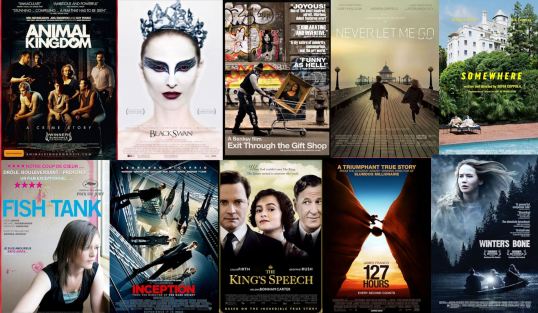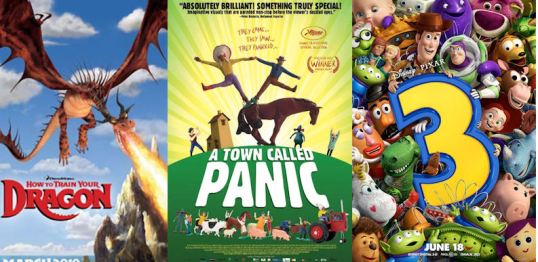With the Oscar nominations due to be announced this week, now seems like a good time to indulge in something I like to call “If Lisa Marie Had All The Power.” Listed below are my personal Oscar nominations. Please note that these are not the films that I necessarily think will be nominated. The fact of the matter is that the majority of them will not. Instead, these are the films that would be nominated if I was solely responsible for deciding the nominees this year. Winners are listed in bold.
Best Picture
Animal Kingdom
Black Swan
Exit Through The Gift Shop
Fish Tank
Inception
The King’s Speech
Never Let Me Go
127 Hours
Somewhere
Winter’s Bone
Best Actor
Patrick Fabian in The Last Exorcism
Colin Firth in The King’s Speech
James Franco in 127 Hours
Andy Garcia in City Island
Ben Stiller in Greenberg
Best Actress
Katie Jarvis in Fish Tank
Jennifer Lawrence in Winter’s Bone
Natalie Portman in Black Swan
Noomi Rapace in The Girl With The Dragon Tattoo
Emma Stone in Easy A
Best Supporting Actor
Christian Bale in The Fighter
Aaron Eckhardt in Rabbit Hole
Andrew Garfield in Never Let Me Go
John Hawkes in Winter’s Bone
Ben Mendelsohn in Animal Kingdom
Best Supporting Actress
Elle Fanning in Somewhere
Rebecca Hall in Please Give
Chloe Grace Moretz in Kick-Ass
Hailee Steinfeld in True Grit
Jacki Weaver in Animal Kingdom
(That’s right, everyone. It’s a tie between the youngest nominee and the oldest nominee. Don’t you just love the Oscars?)
Best Director
Andrea Arnold for Fish Tank
Darren Aronofsky for Black Swan
Danny Boyle for 127 Hours
Sofia Coppola for Somewhere
Christopher Nolan for Inception
Best Original Screenplay
Animal Kingdom
Black Swan
Fish Tank
Inception
The King’s Speech
Best Adapted Screenplay
Never Let Me Go
127 Hours
Rabbit Hole
Toy Story 3
Winter’s Bone
Best Editing
Black Swan
Exit Through the Gift Shop
Inception
127 Hours
Somewhere
Best Cinematography
Black Swan
Somewhere
True Grit
Twelve
Winter’s Bone
Best Art Direction
Black Swan
Harry Potter and the Deathly Hallows, Part One
Inception
The King’s Speech
Scott Pilgrim Vs. The World
Best Sound Mixing
Black Swan
Inception
Secretariat
Stone
Toy Story 3
Best Sound Editing
The Expendables
Inception
Scott Pilgrim Vs. The World
Secretariat
Toy Story 3
Best Costume Design
Black Swan
The Girl With The Dragon Tattoo
Harry Potter and the Deathly Hallows, Part One
Robin Hood
The Wolf Man
Best Original Score
Black Swan
Inception
Machete
127 Hours
Tron: Legacy
(Yes, I know that the Academy has ruled that the original score for Black Swan is not eligible to be nominated. However, these are my nominations and I make the rules.)
Best Visual Effects
Harry Potter and the Deathly Hallows, Part One
Inception
Scott Pilgrim Vs. The World
Splice
Tron: Legacy
Best Makeup
Harry Potter and the Deathly Hallows, Part One
Let Me In
127 Hours
Splice
The Wolf Man
Best Song
“Better Days” from Eat Pray Love
“Bound Together” from Burlesque
“Dear Laughing Doubters” from Dinner For Schmucks
“Sticks and Stones” from How To Train Your Dragon
“You Haven’t Seen The Last of Me” from Burlesque
Best Documentary Feature
Best Worst Movie
Exit Through the Gift Shop
Joan Rivers: A Piece of Work
Restrepo
Winnebago Man
Best Animated Feature
How To Train Your Dragon
A Town Called Panic
Toy Story 3
(Again, I am aware that the Academy ruled that A Town Called Panic isn’t eligible and again, I don’t care.)
Best Foreign Language Film
The Girl With The Dragon Tattoo (Sweden)
Mother (South Korea)
OSS 117 – Lost in Rio (France)
Police, Adjective (Romania)
A Prophet (France)
(While the Academy considers one submission per country for this award, I’m simply using it to recognize the best foreign language film released in the U.S. last year. Or, at least, the best one that I got a chance to see.)
So, since I love lists, here’s a final tally of films by nominations:
10 Nominations — Black Swan
9 Nominations — Inception
7 Nominations — 127 Hours
5 Nominations — Somewhere, Winter’s Bone
4 Nominations — Animal Kingdom, Fish Tank, Harry Potter and the Deathly Hallows, The King’s Speech, Toy Story 3
3 Nominations — Exit Through The Gift Shop, The Girl With The Dragon Tattoo, Never Let Me Go, Scott Pilgrim Vs. The World
2 Nominations — Burlesque, How To Train Your Dragon, Rabbit Hole, Secretariat, Splice, Tron: Legacy, True Grit, The Wolf Man
1 Nomination — Best Worst Movie, City Island, Dinner For Schmucks, Easy A, Eat Pray Love, The Expendables, The Fighter, Greenberg, Joan Rivers: A Piece of Work, Kick-Ass, The Last Exorcism, Machete, Mother, OSS 117 — Lost in Rio, Please Give, Police, Adjective, A Prophet, Restrepo, Robin Hood, Stone, A Town Called Panic, Twelve, Winnebago Man
0 Nominations — The Social Network
And lastly, here’s a tally by imaginary Oscars won:
5 Oscars — Black Swan
2 Oscars — Toy Story 3
1 Oscar — Animal Kingdom, Burlesque, Exit Through The Gift Shop, Fish Tank, The Girl With The Dragon Tattoo, Harry Potter and the Deathly Hallows, Inception, Never Let Me Go, 127 Hours, Scott Pilgrim Vs. The World, Somewhere, Tron: Legacy, Twelve, Winter’s Bone, The Wolf Man
0 Oscars — The Social Network
(One final note: A big thank you to my sister, Erin Nicole Bowman, who created the banners used in this post.)























